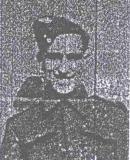Private 4979390 2/5th Sherwood Foresters (Notts and Derby Regt.)
Died Sunday 2nd June 1940 (Age 22)
Commemorated at: Dunkirk Memorial, Dunkirk, Nord, France
Memorial Ref.: Column 95
William Edward Lea (b. 1st Q 1918) was the son of Alfred and Beatrice (nee Gluyas) Lea of Sedgwick Street, Jacksdale.
He had an elder sister named Evelyn Elizabeth Lea born 1915.
William’s father, Albert Lea served in the Royal Garrison Artillery during WW1, but is not mentioned as having served on the Jacksdale War Memorial.
Albert attested in February 1916, aged 32 years, address at time of attestation being 2, Cecil Cottages, Albert Avenue, but a previous address of Laverick Road is also mentioned. He was not mobilised until March 1918. In September 1918 Albert was discharged as medically unfit for service, suffering from epilepsy. His records state that the condition was not caused or aggravated by his army service. He was awarded a pension of 7 shillings and 10 pence a week for thirteen weeks and demobbed to Coverack Bridges, Near Helston, Cornwall.
William’s mother Beatrice Gluyas originated from Wendron, Cornwall and in 1911 was living in Ethel Cottages, Albert Avenue, Jacksdale with her uncle and aunt Samuel and Ellen Gregory, who tragically lost their son Samuel Gregory in WW1. In 1914 Beatrice and Albert Lea married. Presumably Beatrice was in Cornwall at the time of Albert’s discharge, or they chose to stay in that area for a time. It seems that the tragedy continued as, in March 1926, Beatrice Lea wrote to Albert’s regiment as his army pension had been stopped. She asked for details of his service career and explained that Alfred has been committed to an asylum and a ‘once hard working man who kept his family well, has now been reduced to a total wreck. She asked why the army pension had ceased and explained that she and her two children had become totally dependent upon the ‘Parish’. The army returned a brief reply detailing Albert’s dates of service and appear to have offered no explanation or apparent concern. It is not known whether Albert made any kind of recovery or how Beatrice and the children fared whilst growing up.
Despite the sad events surrounding his father, William grew up to be a fine young man. Very popular, a member of the Church Boy’s Club and a regular worshipper at St Mary’s, Westwood.
His peacetime employment was at the brickworks of Messrs. James Oakes and Co.
In December 1939, William married Elsie (nee White and formerly of New Brinsley) and they set up home at Plainspot, Brinsley. In January 1940, less than two months after the wedding, William was called up.
About six months later, during the summer of 1940, the Eastwood & Kimberley Advertiser reported that Private W Lea was missing. It was the first report of a soldier originating from Brinsley being listed as missing. Private Lea was believed to be a member of the B.E.F. on active service prior to the Dunkirk evacuation.
Nearly a year later, on 6th June 1941, the Eastwood & Kimberley Advertiser reported that Elsie had still not heard from her husband and ‘had just received a letter from the War Office which states the Casualty Department is pursuing every possible line of enquiry in the hope of securing some news concerning Private Lea’. The War Office had been in communication with another Brinsley soldier who was out there with the missing man, and whom it had been rumoured, had some knowledge of his fate, but the War Office letter went on to say: “unfortunately this soldier was unable to give any information about the fate of Private Lea.” Mrs. Lea still holds out in the hope of receiving good news regarding her husband, and readers will join in sympathizing with her during this long period of anxiety”.’
The Commonwealth War Graves Commission records William Lea’s date of death as Sunday 2nd June 1940, at age 22.
He is commemorated on the Dunkirk Memorial, Nord, France. The memorial commemorates over 4,000 men of the British Expeditionary Force who fell in the campaign of 1939 – 1940 and have no known grave.
William Lea was also remembered by his fellow workmates on the James Oakes & Co (Riddings Collieries) Ltd – Claywork’s Department Roll of Employees Serving With H.M. Forces who had made “The Supreme Sacrifice”. The Roll of Honour was displayed in the works’ canteen for many years after the war, right up to the late 1960s. Luckily the Roll of Honour was rescued by an employee when the pit closed.
William Lea’s name was also inscribed upon a brass plaque situated in the Chancel of the church at nearby Stoneyford. The church, which was a tin tabernacle, has since been moved intact and re-erected at the Butterley Railway Museum, Ripley. The plaques were taken to Ironville, Christ Church.













